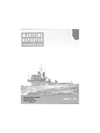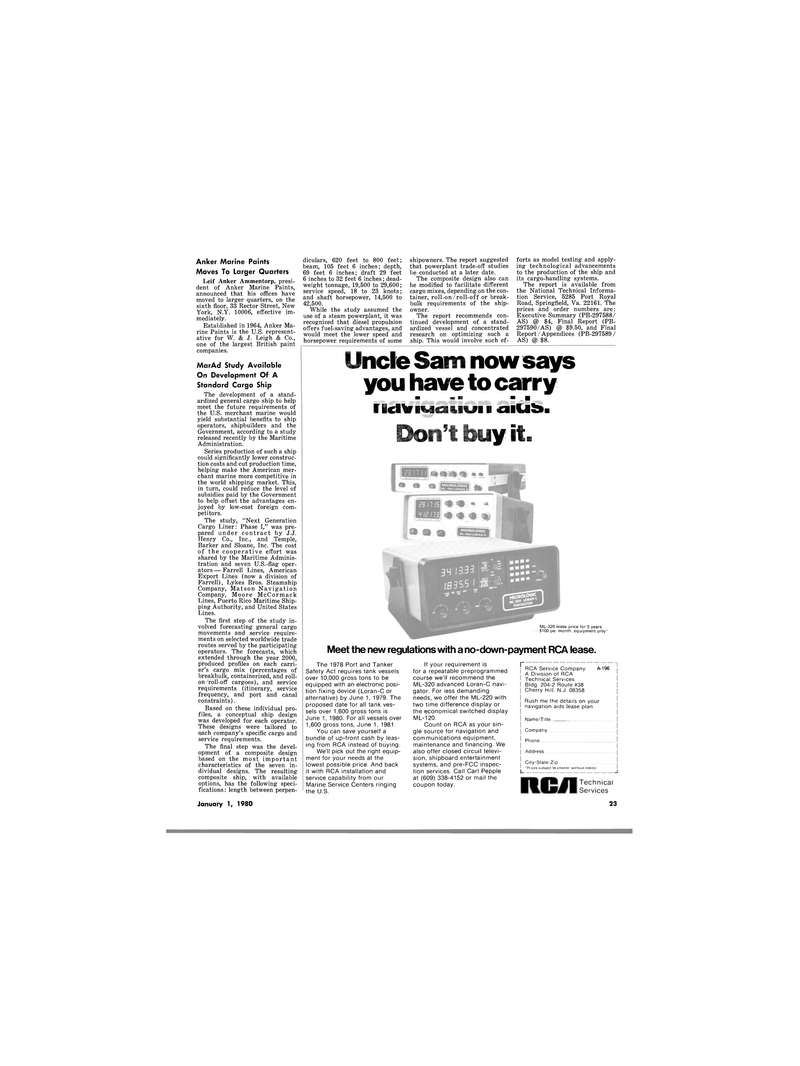
Page 15: of Maritime Reporter Magazine (January 1980)
Read this page in Pdf, Flash or Html5 edition of January 1980 Maritime Reporter Magazine
Anker Marine Paints
Moves To Larger Quarters
Leif Anker Ammentorp, presi- dent of Anker Marine Paints, announced that his offices have moved to larger quarters, on the sixth floor, 33 Rector Street, New
York, N.Y. 10006, effective im- mediately.
Established in 1964, Anker Ma- rine Paints is the U.S. represent- ative for W. & J. Leigh & Co., one of the largest British paint companies.
MarAd Study Available
On Development Of A
Standard Cargo Ship
The development of a stand- ardized general cargo ship to help meet the future requirements of the U.S. merchant marine would yield substantial benefits to ship operators, shipbuilders and the
Government, according to a study released recently by the Maritime
Administration.
Series production of such a ship could significantly lower construc- tion costs and cut production time, helping make the American mer- chant marine more competitive in the world shipping market. This, in turn, could reduce the level of subsidies paid by the Government to help offset the advantages en- joyed by low-cost foreign com- petitors.
The study, "Next Generation
Cargo Liner: Phase I," was pre- pared under contract by J.J.
Henry Co., Inc., and Temple,
Barker and Sloane, Inc. The cost of the cooperative effort was shared by the Maritime Adminis- tration and seven U.S.-flag oper- ators — Farrell Lines, American
Export Lines (now a division of
Farrell), Lykes Bros. Steamship
Company, Matson Navigation
Company, Moore McCormack
Lines, Puerto Rico Maritime Ship- ping Authority, and United States
Lines.
The first step of the study in- volved forecasting general cargo movements and service require- ments on selected worldwide trade routes served by the participating operators. The forecasts, which extended through the year 2000, produced profiles on each carri- er's cargo mix (percentages of breakbulk, containerized, and roll- on /roll-off cargoes), and service requirements (itinerary, service frequency, and port and canal constraints).
Based on these individual pro- files, a conceptual ship design was developed for each operator.
These designs were tailored to each company's specific cargo and service requirements.
The final step was the devel- opment of a composite design based on the most important characteristics of the seven in- dividual designs. The resulting composite ship, with available options, has the following speci- fications: length between perpen- diculars, 620 feet to 800 feet; beam, 105 feet 6 inches; depth, 69 feet 6 inches; draft 29 feet 6 inches to 32 feet 6 inches; dead- weight tonnage, 19,500 to 29,600; service speed, 18 to 23 knots; and shaft horsepower, 14,500 to 42,500.
While the study assumed the use of a steam powerplant, it was recognized that diesel propulsion offers fuel-saving advantages, and would meet the lower speed and horsepower requirements of some shipowners. The report suggested that powerplant trade-off studies be conducted at a later date.
The composite design also can be modified to facilitate different cargo mixes, depending on the con- tainer, roll-on/roll-off or break- bulk requirements of the ship- owner.
The report recommends con- tinued development of a stand- ardized vessel and concentrated research on optimizing such a ship. This would involve such ef- forts as model testing and apply- ing technological advancements to the production of the ship and its cargo-handling systems.
The report is available from the National Technical Informa- tion Service, 5285 Port Royal
Road, Springfield, Va. 22161. The prices and order numbers are:
Executive Summary (PB-297588/
AS) @ $4, Final Report (PB- 297590/AS) @ $9.50, and Final
Report/Appendices (PB-297589 /
AS) @ $8.
Uncle Sam now says you have to carry • • • lie! « S « 111 tiSin
Don't buy It.
Ml-320 $100 pei lease price for 5 years month, equipment only'
Meet the new regulations with a no-down-payment RCA lease.
The 1978 Port and Tanker
Safety Act requires tank vessels over 10,000 gross tons to be equipped with an electronic posi- tion fixing device (Loran-C or alternative) by June 1, 1979. The proposed date for all tank ves- sels over 1,600 gross tons is
June 1, 1980. For all vessels over 1,600 gross tons, June 1, 1981.
You can save yourself a bundle of up-front cash by leas- ing from RCA instead of buying.
We'll pick out the right equip- ment for your needs at the lowest possible price. And back it with RCA installation and service capability from our
Marine Service Centers ringing the U.S.
If your requirement is for a repeatable preprogrammed course we'll recommend the
ML-320 advanced Loran-C navi- gator. For less demanding needs, we offer the ML-220 with two time difference display or the economical switched display
ML-120.
Count on RCA as your sin- gle source for navigation and communications equipment, maintenance and financing. We also offer closed circuit televi- sion, shipboard entertainment systems, and pre-FCC inspec- tion services. Call Carl Pepple at (609) 338-4152 or mail the coupon today. r RCA Service Company A-196
A Division of RCA
Technical Services
Bldg. 204-2 Route #38
Cherry Hill. N.J. 08358
Rush me the details on your navigation aids lease plan.
Name/Title
Company
Phone
Address
City/State/Zip ' Pi ices subject to ct anni• without notice
I I
ItCJl Technical Services
January 1, 1980 23

 14
14

 16
16
